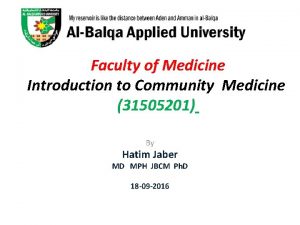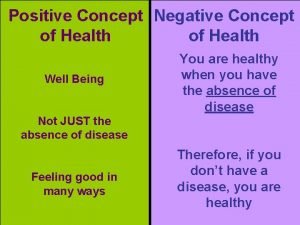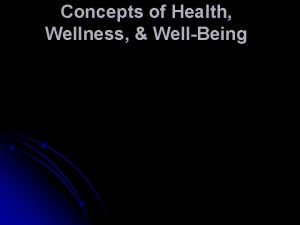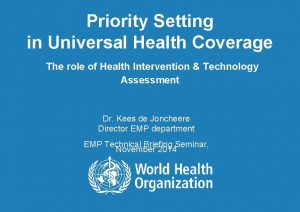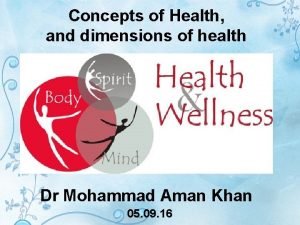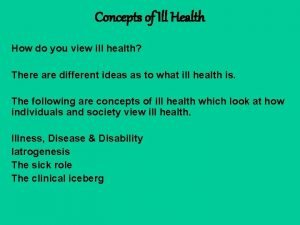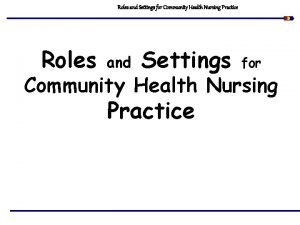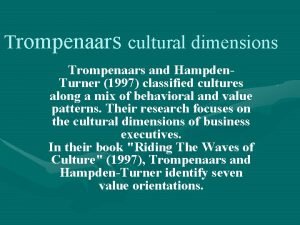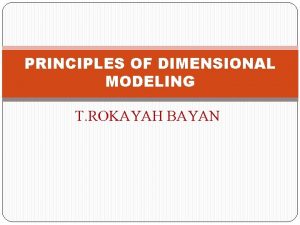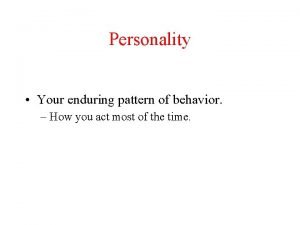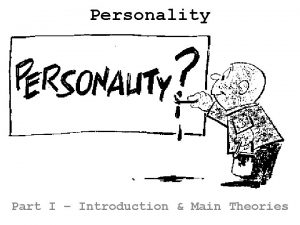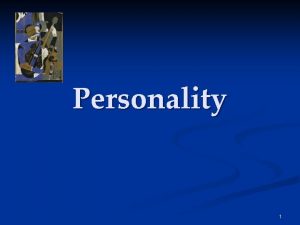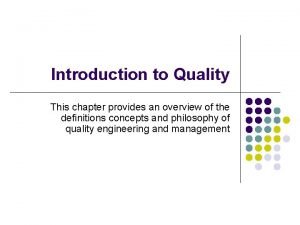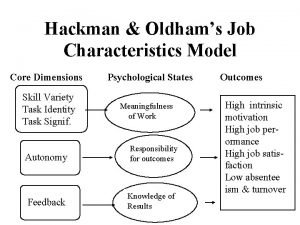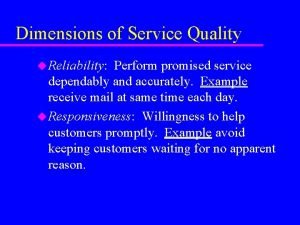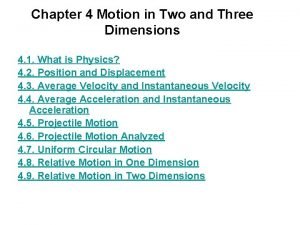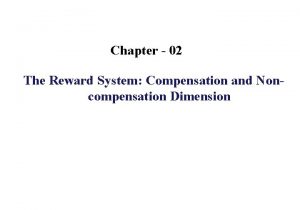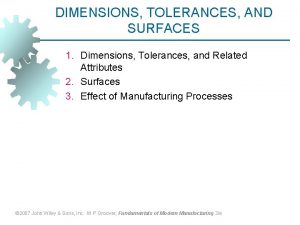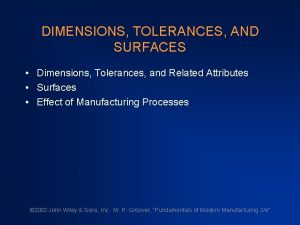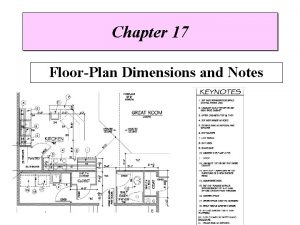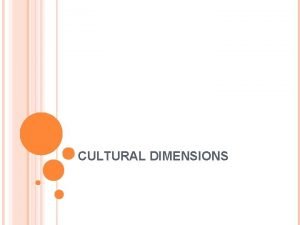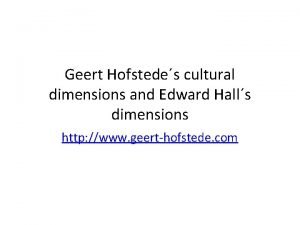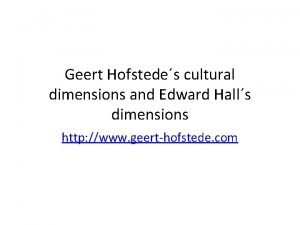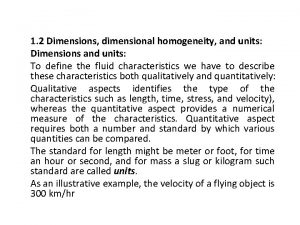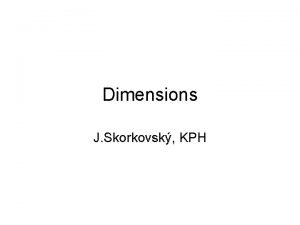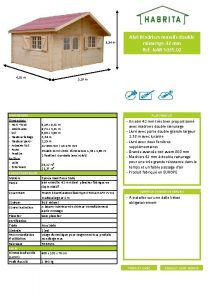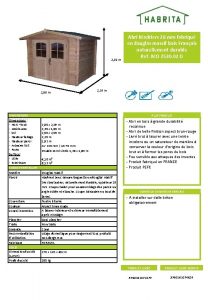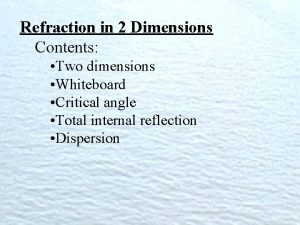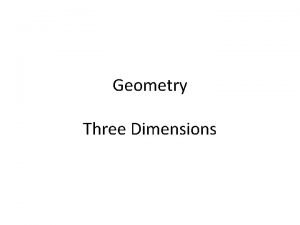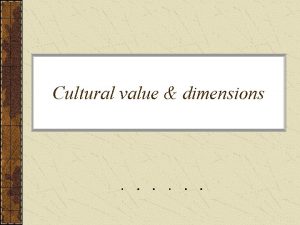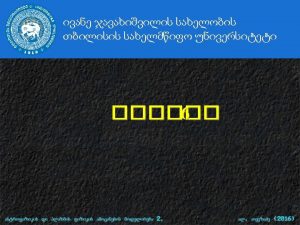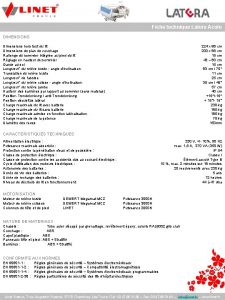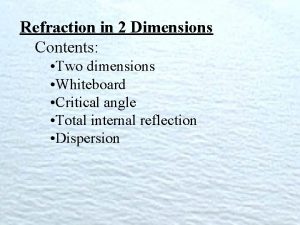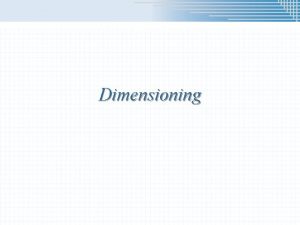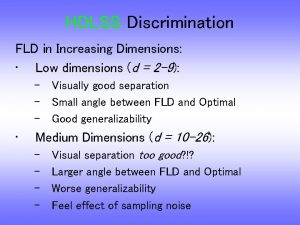Concepts of Health and dimensions of health Dr



























- Slides: 27

Concepts of Health, and dimensions of health Dr Mohammad Aman Khan 05. 09. 16

After the end of this lectutre the student will be able to know: • What is health? • Different dimensions of health • Various models of health. • Determinants of health status


What is Health?

• What are the determinants of Health? – Positive influence on health – Negative – Examples? ?

What is Health • “Health is state of complete physical, mental, spiritual and social well being and not merely the absence of disease” and the ability to lead a socially and economically productive life” WHO

Health • There is no consensus (agreement) about any definition of health. There is knowledge of how to attain (reach) a certain level of health, but health itself cannot be measured. • Traditionally health has been defined in terms of the presence or absence of disease. • Nightingale defined health as a state of being well and using every power the individual possesses to the fullest extent

Introduction • Health, wellness, and well-being have many definitions and interpretations. • The doctors and other health professionals should be familiar with the most common aspects of the concepts of health and consider how they may be individualized with specific individuals / clients.

the American Nurses Association defined health • a dynamic state of being in which the developmental and behavioral potential (possible) of an individual is realized to the fullest extent possible

Most people define and describe health as the following: • Being free from symptoms of disease and pain as much as possible. • Being able to be active and to do what they want or must. • Being in good spirits most of the time.

Ageing Autoimmune process Nutrition Trauma Physical Thermal Electrical Mental Social Spiritual Environmental

Dimensions of health / disease Copyright 2008 by Pearson Education, Inc.

Dimensions of health Physical Mental Emotional Spiritual

Physical. • The ability to carry out daily tasks, achieve fitness (e. g. pulmonary, cardiovascular, gastrointestinal), maintain adequate nutrition and proper body fat, avoid abusing drugs and alcohol or using tobacco products, and generally to practice positive lifestyle habits.

Mental • The ability to interact successfully with people and within the environment

Emotional. • The ability to manage stress and to express emotions appropriately, • Emotional wellness involves the ability to recognize, accept, and express feelings.

Spiritual. • The belief in some force (Allah, nature, science, religion, or a higher power) that serves to unite human beings and provide meaning and purpose of life.

Intellectual. • The ability to learn and use information / skills effectively for personal, family, and community development.

The determinants of health (WHO) • Many factors combine together to affect the health of individuals and communities. • Whether people are healthy or not, is determined by their circumstances and environment. • To a large extent, factors such as • where we live, • the state of our environment, • genetics, • our income and education level, and • our relationships with friends and family all have considerable impacts on health, whereas the more commonly considered factors such as access and use of health care services often have less of an impact.

Bio-Psycho-social model of health

Models of Health • • • Clinical Model Role Performance Model Adaptive Model Agent-Host-Environment Model Health-Illness Continuum .

Clinical Model • Provides the narrowest interpretation of health • People viewed as physiologic systems • Health identified by the absence of signs and symptoms of disease or injury • State of not being “sick” • Opposite of health is disease or injury Copyright 2008 by Pearson Education, Inc.

Role Performance Model • Ability to fulfill societal roles • Healthy even if clinically ill if roles fulfilled • Sickness is the inability to perform one’s role

Adaptive Model • Creative process • Disease is a failure in adaptation or maladaptation • Extreme good health is flexible adaptation to the environment • Focus is stability • The aim of treatment is to restore the ability of the person to adapt.

Agent-Host-Environment Model • Each factor constantly interacts with the others • When in balance, health is maintained • When not in balance, disease occurs Copyright 2008 by Pearson Education, Inc.

Health-Illness Continuum • Measure person’s perceived level of wellness • Health and illness/disease opposite ends of a health continuum • Move back and forth (forward) within this continuum day by day • Wide ranges of health or illness Copyright 2008 by Pearson Education, Inc.

• Thank You
 Biomedical concept of health
Biomedical concept of health Introduction to community medicine
Introduction to community medicine Concept of health
Concept of health Concepts of health and wellbeing
Concepts of health and wellbeing Goals of universal health coverage
Goals of universal health coverage Dimensions of universal health coverage
Dimensions of universal health coverage Dimensions of health
Dimensions of health Concepts of primary health care
Concepts of primary health care Defining fitness
Defining fitness Concepts of ill health
Concepts of ill health Role of community health nurse
Role of community health nurse Health and social component 3
Health and social component 3 Data and process modeling
Data and process modeling Typical process description tools include
Typical process description tools include Class instructional support domain
Class instructional support domain Trompenaars and hampden-turner cultural dimensions
Trompenaars and hampden-turner cultural dimensions T-tess domains summary
T-tess domains summary Any queries slide
Any queries slide Enduring pattern of behavior
Enduring pattern of behavior Hans and sybil eysenck personality dimensions
Hans and sybil eysenck personality dimensions Hans and sybil eysenck personality theory
Hans and sybil eysenck personality theory Hans and sybil eysenck personality dimensions
Hans and sybil eysenck personality dimensions Quality dimensions of goods and services
Quality dimensions of goods and services Hackman and oldham's core job dimensions
Hackman and oldham's core job dimensions Geometric tolerance
Geometric tolerance Quality dimensions of goods and services
Quality dimensions of goods and services Motion in two and three dimensions
Motion in two and three dimensions Noncompensation
Noncompensation

